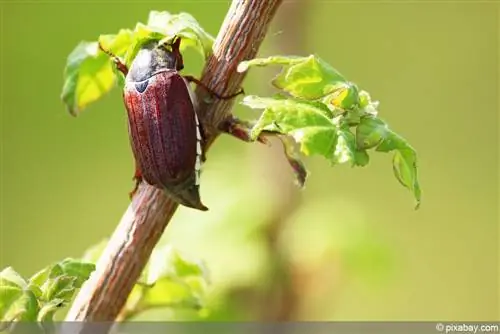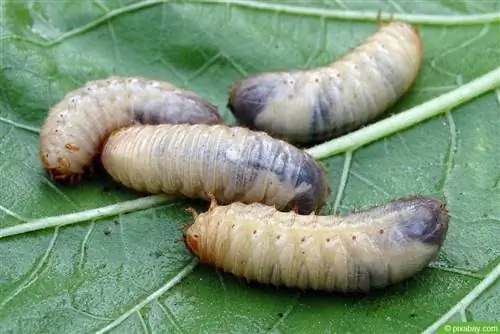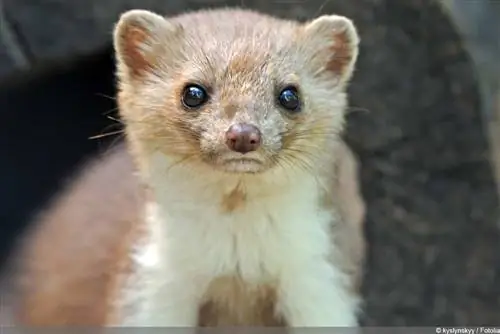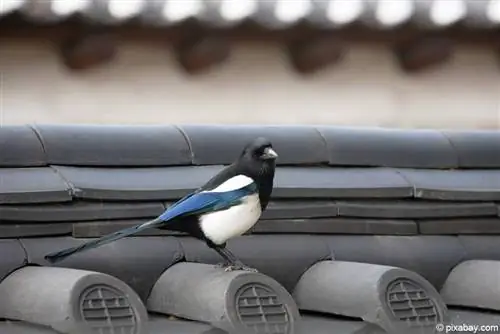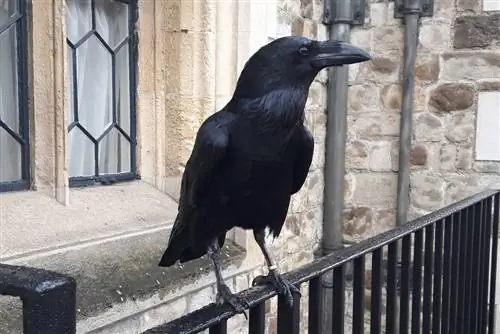- Author admin [email protected].
- Public 2023-12-17 03:39.
- Last modified 2025-06-01 06:48.
In the wonderful month of May, when the warm rays of sunshine entice you into the garden and the plants begin to grow and bloom, it hums and hums, especially in the evening hours. May beetles eat the young greenery from the trees - and lay their eggs in the ground, from which the grubs later hatch. In large occurrences, these damage the plant roots and must be combated.
Occurrences
The cockchafer (Melolontha) has become rare. The stories of our grandparents, how they collected the pretty, brown beetles in boxes in the afternoon after school and sometimes even ate them, for example during times of emergency during the world wars, are only known to those of us who come after us from stories. Nowadays, in some regions of Germany you hardly see a May beetle anymore, in others, however, the insect, which belongs to the scarab beetle family (Scarabaeidae), is once again becoming a threat to forests and gardens.
Increased appearance
The cockchafers, which were massively combated and almost eradicated in the 1950s and 60s by pesticides such as DDT - which is now banned for good reasons - have been increasingly occurring in recent years, primarily in southwest Germany. Here they are mainly found in beech and oak forests as well as in larger orchards, because cockchafers prefer the young greenery of deciduous trees - and of course increasingly lay their eggs near them.
Habitats
While the adults fly around between trees and bushes and eat them bare when there is a lot of growth, their larvae live in the ground for up to four years. The thick, white grubs that look like thick, white maggots thrive best in loose, humus-rich and clay-rich soils, while they are rarely found in sandy, dry, poor and swampy subsoils. Scientists distinguish three different species of May beetles that claim similar habitats:
- Field cockchafer (Melolontha melolontha): also common cockchafer, prefers open and unforested habitats, often in fields, gardens and meadows
- Forest Cockchafer (Melolontha hippocastani): preferably in deciduous forests with lots of oak, beech and maple trees, rarely also in coniferous forests
- Melolontha pectoralis: very rare in Germany and limited to the southwest, prefers warm and rather dry habitats
Recognize
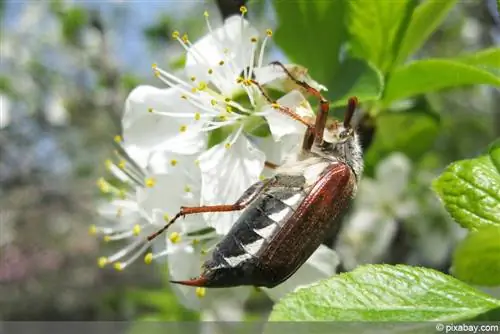
Adult cockchafers quickly catch the eye, especially when they appear in large numbers:
- up to three centimeters long
- have fan-like antennae on the sides of the head
- brown wing shield
The larvae, known as grubs, live in the soil and are often only discovered through soil preparation measures such as digging. You can recognize them by these features:
- resemble thick, white maggots
- often a thickened, blackish rump
- a brown head
- three pairs of legs in the front area of the body
Tip:
Unlike cockchafers, rose beetles are quite useful animals in the garden, although their grubs look very similar to those of the cockchafer. However, you can distinguish them by a test: place the larvae on a flat surface. Rose beetle larvae stretch out and crawl on their backs, while May beetle larvae curl up and simply lie there.
Lifecycle
The life of an adult cockchafer only lasts a short four to six weeks, during which the males die immediately after mating with the females. Females are typically responsible for clearing the trees, as they use so-called “ripening” to ensure that their eggs become ripe for laying. Depending on the species, the females lay their eggs either near trees and larger trees or directly into the ground on lawns, beds and borders as well as meadows.
They dig hollows in the ground to lay their eggs and then die. The grubs that hatch from this live in the soil for between three and five years, preferring to feed on plant roots and then burrow out after pupating. Adults fly mainly between April and May, occasionally even at the beginning of June. The animals that fly later are the similar-looking but smaller June beetles.
Tip:
Cockchafers are increasingly appearing in cycles. About every fourth year is a “cockchafer year,” which is explained by the animals’ life cycle. Due to their increased appearance, which used to be massive in earlier times, the beetles make things difficult for their predators: After all, they could not eat all the individuals in a swarm, so there were always enough beetles left over for reproduction.
Prevention
Anyone who is familiar with the life cycles and habits of animals can roughly estimate when a “May beetle year” might happen again. The grubs pupate in one in order to lay massive numbers of eggs during the flight season in April and May. You can make this task difficult for the animals using various methods:
- Insect protection nets: Close-meshed nets prevent flight, egg laying and fertilization of these
- Plans: Cover lawns with tarpaulins in the evenings
- Light: Keep the garden dark during flight time, cockchafers are attracted to light sources
- Planting: Plant plenty of garlic, delphiniums and geraniums in the garden
You can plant the three types of plants mentioned in all beds and borders if you have had problems with grubs or cockchafers in previous years. The animals do not like garlic because of the smell and instinctively avoid areas planted with the allium plant to lay their eggs. The roots of delphiniums and geraniums, on the other hand, are often eaten by grubs, but are fatally poisonous to them.
Fight
If the lawn turns yellow for no apparent reason, shrubs and trees die for seemingly no reason and your garden plants generally seem to have a problem, then grubs may be behind it. You can discover these by digging up the ground in suspected places. If too many of the animals appear, it is high time for effective countermeasures.
Collect
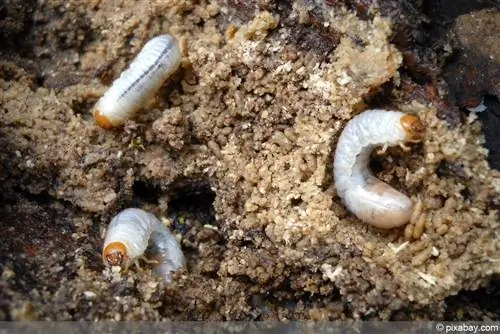
Go into the garden immediately after a heavy downpour and simply collect the grubs. The animals come to the top like earthworms, otherwise they would drown. Then take them into nature and release them there. By the way, you can simulate heavy rain and thus the emergence of the larvae by watering the affected garden areas heavily.
Soil preparation
Numerous grubs can also be collected before pupation during the annual digging in spring. You should regularly hoe through borders and perennial beds and scarify lawns. This disturbs the larvae and often dies.
Tip:
Grubs prefer to stay near the compost or manure heap in the garden. If you dig in root protection grids and deep lawn curbs in these areas, the animals will not spread into other garden areas.
Applying nematodes
Tiny roundworms, so-called nematodes, have proven to be a useful biological control measure. You can purchase these from gardening stores and spread them in the garden using irrigation water. The nematodes kill the grubs, but not only them. Other insect larvae - for example beneficial insects - are also affected.
Insecticides and other chemical agents
However, you should be careful with insecticides and only use them when nothing else really helps. “EngerlingFrei” and similarly named products not only kill the cockchafer larvae, but also important beneficial insects. In addition, the chemical substances have other undesirable effects on the flora and fauna in the garden.
Tip:
Instead, set a completely biological trap for the cockchafers: In the spring, dig a bucket filled to the brim with horse manure and compost. The female beetles are attracted by the smell and prefer to lay their eggs in this trap.
4 natural predators
However, cockchafers and especially their grubs are not only a nuisance, but also protein-rich and therefore welcome food for many animals. If you make your garden animal-friendly, then birds and hedgehogs will prefer to settle here and not only keep cockchafer larvae away, but also many other pests.
Birds
Blackbirds in particular like to eat the fat grubs, as do sparrows, titmice and other songbirds. Install birdhouses in the garden and plant dense hedges and trees: then the feathered companions will quickly feel at home with you. You can also attract many birds by feeding them in winter.
Hedgehog
Hedgehogs not only like to eat cockchafer larvae, but also slugs and other unwanted garden inhabitants. Place hedgehog houses in sheltered places, offer dense hedges and, in autumn, larger piles of leaves and brushwood as hiding places.
moles

Moles, for their part, are not particularly popular in the garden because they dig through everything without paying any attention to the plants or the beautiful lawn and create the characteristic piles. What hardly any gardener knows, however, is that the black creatures are annoying, but very useful when it comes to getting rid of grubs and other voracious pests - for example the black weevil. In addition, with their diligent digging, they ensure thorough mixing of the soil and thus increase the quality of the soil.
Shrews
The cute animals look like mice, but they aren't. In contrast to annoying rodents, they are insectivores and feed primarily on grubs and other insect larvae. You can easily recognize shrews by their elongated, pointed snouts. They have a high food requirement and thus keep the larval population in the garden well in check.

